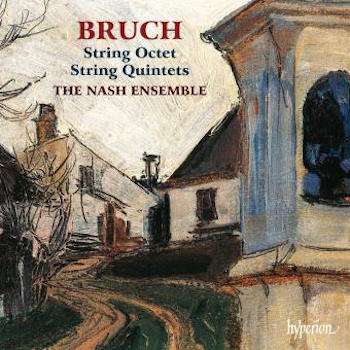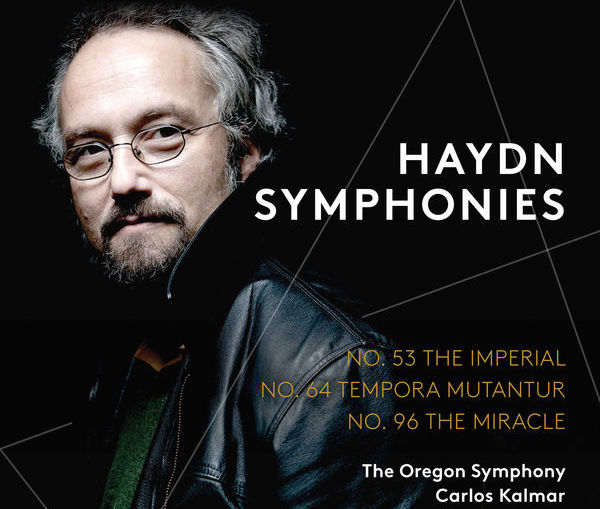Classical CD Reviews: the Nash Ensemble’s Bruch and Carlos Kalmar’s Haydn
A welcome triumph for Hyperion, Bruch, and the Nash Ensemble, but the Oregon Symphony does not do right by Haydn.
By Jonathan Blumhofer

Poor Max Bruch, a composer whose substantial output is completely overshadowed by the immense popularity of two (of his four) violin concertos. But Bruch’s conservatism wasn’t dry and fusty. He was, after all, a fine melodist and a gifted contrapuntist. Both of those characteristics really bubble over in the two late String Quintets and the Octet, all written over the last couple years of his life (between 1918 and ’20) and now out on a fine new recording from the Nash Ensemble on Hyperion.
The Nash players do their parts to bring the set to life. Bruch’s haunting lyricism is always given pride of place: the achingly beautiful slow movement of the E-flat Quintet sings, as does the pensive Adagio of the A-minor Quintet and the strict, sometimes martial central movement of the Octet.
But there’s more to this music than just lots of pretty, slow episodes. The colorful moments – from the liquidy opening of the E-flat Quintet’s first movement to the bustling, explosive beginning of the Octet’s finale – come magically to life here. And Bruch’s spirited, scherzando-ish writing (which is really a significant part of his style only partly tapped in the violin concertos and Scottish Fantasy) is always articulated with lightness and precision.
Violinist Stephanie Gonley is the front-and-center star of most of the album, playing with sweet, warm tone and occasional touches of portamento. But the writing for the rest of the group is involved, especially during the various vigorous finales. The playing of the Nash Ensemble is quite lively, well-balanced, and attuned to the expressive nuances of Bruch’s style. Adrian Brendel anchors the group with some sonorous cello playing in the Quintets; he’s joined by bassist Peter Buckoke to fill out a robust bass section in the Octet.
In all, the album’s a more-than welcome triumph for Hyperion and the Nash Ensemble, but also for Bruch, whose wider catalogue certainly deserves (and can use) advocacy of just this kind.

They may not have the same name recognition or cachet as, say, the San Francisco Symphony or New York Philharmonic, but the Oregon Symphony is a fine one, indeed. Recent American- and war-themed albums with their music director Carlos Kalmar certainly bear this out. Unfortunately, the magic of those prior discs – Spirit of the American Range and Music for a Time of War, chief among them – is wholly absent from their new traversal of Haydn’s Symphonies nos. 53, 64, and 96 on Pentatone.
This is surprising given the quality of the ensemble’s playing, which is clean, clear, and genial. There seems to be an element of periodicity to the performances (light string textures, minimal vibrato, etc.) that is meant to give them a certain lift and spirit. Yet the interpretations generally lack definition, are oftentimes short on energy, and consistently exhibit an infinitesimal degree of personality. If you think that last quality is an odd one for a Haydn recording, you’re right: here’s a composer who’s intelligent, affable charisma is almost impossible to separate from the music. Managing to do so takes a fair amount of work.
Now, it’s true that there are a couple of spots on this album where Haydn’s smile peeks through despite the wooden performances, namely in the finale of the Symphony no. 53 and the parts of the second movement of no. 96. But those are the exceptions: otherwise, the readings here are basically flat and graceless.
Where’s the mystery in the first-movement introductions of nos. 53 and 96? Nowhere to be found on this disc. The music happens matter-of-factly – and it doesn’t seem to be having much fun coming to life in the process.
Ditto all three minuets which, with the exception of parts of no. 96’s third movement, are strict rhythmic exercises, lacking charm and lilt.
So are the supposed-to-be-peppy finales. No. 96’s starts off well but ebbs; there’s little palpable joy to be found in its pages. No. 64’s is a snooze-fest: limpid, articulated without energy, flat like a Kansas prairie. No. 53’s “Capriccio” breaks out of this tendency the best but never dances with full abandon; something always seems to be being held back.
As for the slow movements, well, they range from the mono-dynamic (no. 53) to the sluggish (no. 64) to the rhythmically-square (no. 96). The latter, at least, benefits from some nice string and wind solos, but that only carries things so far.
In short, one never get the sense from this disc that Haydn was one of Western music’s great innovators, wits, and compositional magicians. Or that his music is revelatory or a joy to perform. Rather, the impression is that he wrote nice music one needn’t get too worked up to play or too excited to listen to, perfect for having on in the background while you’re making dinner or at least where you needn’t pay it much attention.
Despite great recorded sound and technically solid playing, there are simply too many better interpretations of these symphonies – from Bernstein, Karajan, and Szell in the big-orchestra tradition to Harnoncourt, Hogwood, and Brüggen with period instruments – to spend time or money on this one.
Jonathan Blumhofer is a composer and violist who has been active in the greater Boston area since 2004. His music has received numerous awards and been performed by various ensembles, including the American Composers Orchestra, Kiev Philharmonic, Camerata Chicago, Xanthos Ensemble, and Juventas New Music Group. Since receiving his doctorate from Boston University in 2010, Jon has taught at Clark University, Worcester Polytechnic Institute, and online for the University of Phoenix, in addition to writing music criticism for the Worcester Telegram & Gazette.
Tagged: Bruch, Carlos Kalmar, Haydn, Hyperion, Nash Ensemble
